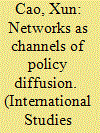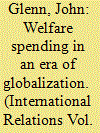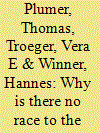| Srl | Item |
| 1 |
ID:
099118


|
|
|
|
|
| Publication |
2010.
|
| Summary/Abstract |
This paper studies policy changes in capital taxation by focusing on policy interdependence induced by network dynamics at the international level. The empirical findings indicate that the competition mechanism induced by network position similarity in the network of portfolio investment and that of exports causes policy diffusion in corporate taxation; the socialization mechanism (policy learning and emulation) induced by network position proximity in the IGO networks also drives policy changes, and the evidence is much stronger in the IGO networks that facilitate policy learning than in those that facilitate emulation. The paper also discusses explicitly empirical challenges to incorporate network characteristics into connectivity matrices in spatial lag models often used to study policy diffusion. It suggests that students of policy diffusion should discuss as explicitly as possible the assumptions and procedures to construct connectivity matrices and present results from alternative specifications: our conclusion on the strength of policy diffusion is often sensitive to the choice of connectivity matrices.
|
|
|
|
|
|
|
|
|
|
|
|
|
|
|
|
| 2 |
ID:
087459


|
|
|
|
|
| Publication |
2009.
|
| Summary/Abstract |
This paper examines the assertion that economic globalization has led to the decline of welfare spending in recent decades. Although it is often argued that the increasing intensity of globalization has led to such a decline in the industrialized states, the paper finds that there has been little, if any, downturn in either levels of state expenditure in general or in levels of welfare spending in particular. However, the experience of the developing states has been rather different. In their case, the last few decades indicate that stagnation or a decline in welfare spending has occurred, particularly during the period of structural adjustment implementation. It is argued that the OECD countries still manage to provide a high level of social welfare to their populations that closely resembles the compensatory state model. In contradistinction, many of the states in the South have struggled to maintain their levels of social expenditure and therefore most resemble Cerny's competitive state model. In order to explain these two divergent outcomes, the paper examines the way in which the behaviour of certain key international financial actors (investors, multinational companies, international financial institutions) differs with regard to these two sets of countries.
|
|
|
|
|
|
|
|
|
|
|
|
|
|
|
|
| 3 |
ID:
091031


|
|
|
|
|
| Publication |
2009.
|
| Summary/Abstract |
This article explains the absence of a race to the bottom in capital taxation by analyzing fiscal competition under budget rigidities and tax equity constraints (fairness norms). We outline a political economic model of tax competition that treats the outcome of tax competition as one argument in the governments utility function, the others being public expenditure and tax equity. In accordance with previous theoretical research, tax competition tends to cause a reduction in taxes on mobile capital and an increase in the tax rates on relatively immobile labor in our model. Yet, our model predicts that governments do not fully abolish taxes on mobile capital. Instead, the government being least restricted by budget constraints and equity norms cuts tax rates to levels slightly below the lowest tax rates of those countries, in which governments are more constrained, where effective constraints are country size, budget rigidities and fairness norms. Analyzing data from 23 Organization for Economic Co-operation and Development countries between 1975 and 2004 we find empirical support for the hypotheses derived from our theoretical model.
|
|
|
|
|
|
|
|
|
|
|
|
|
|
|
|